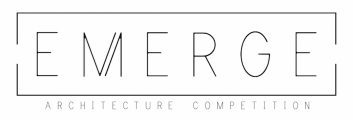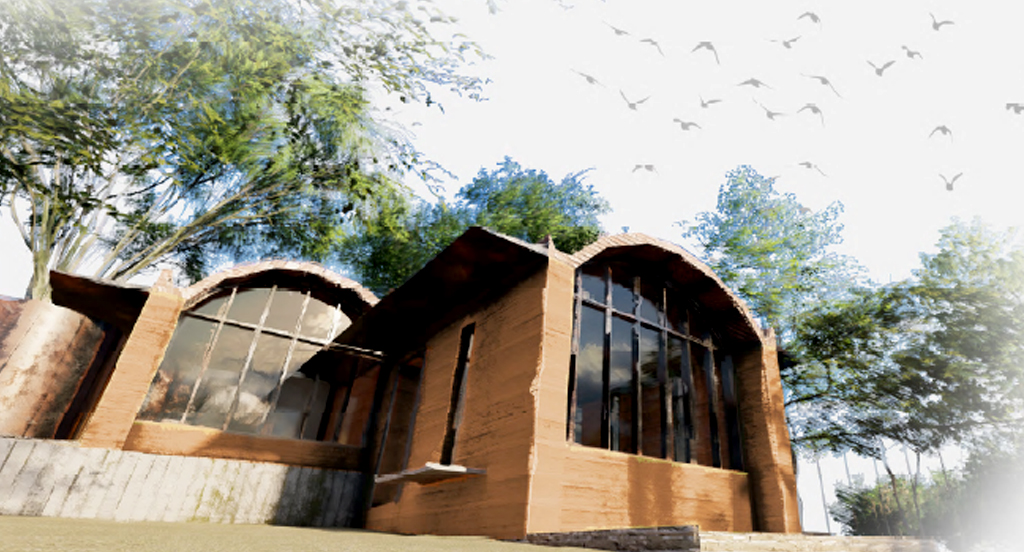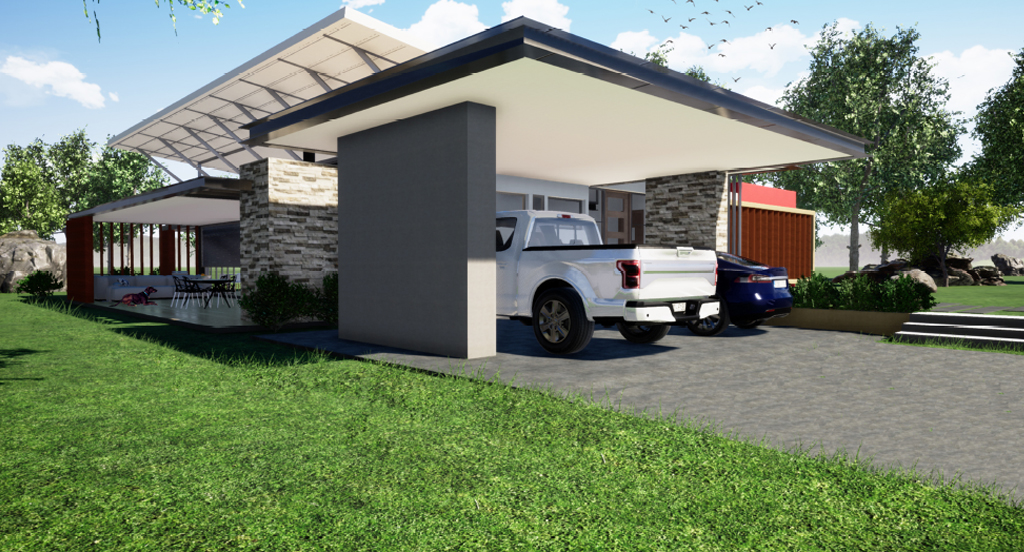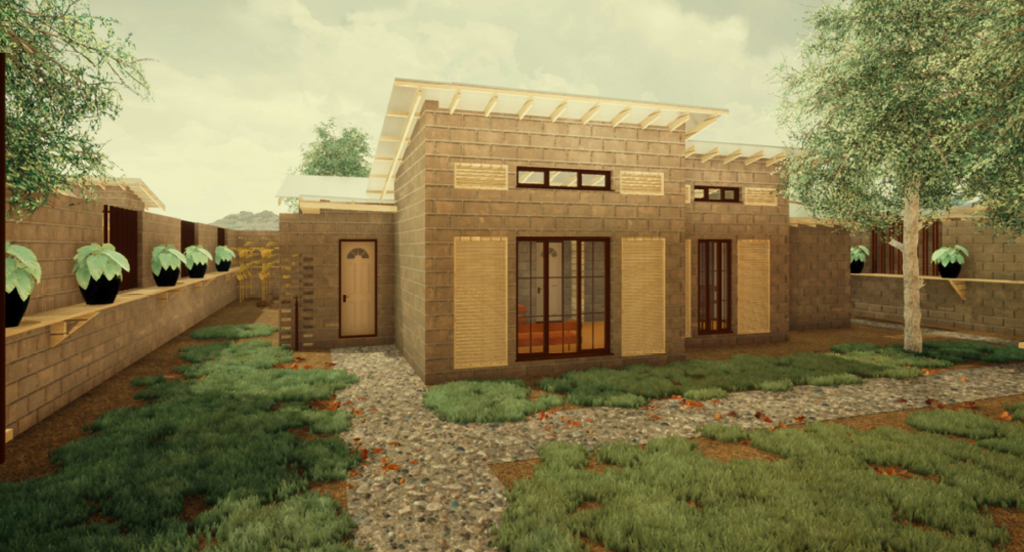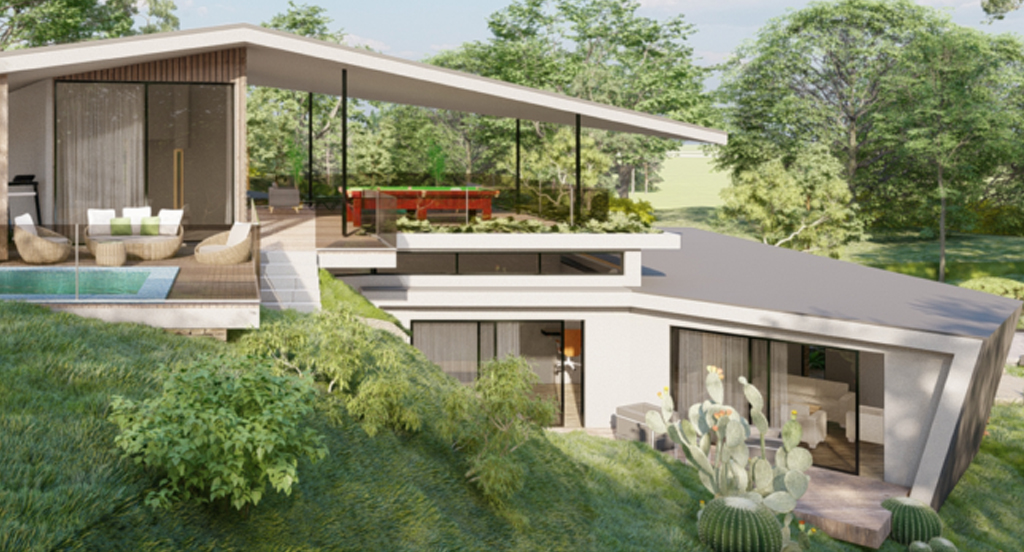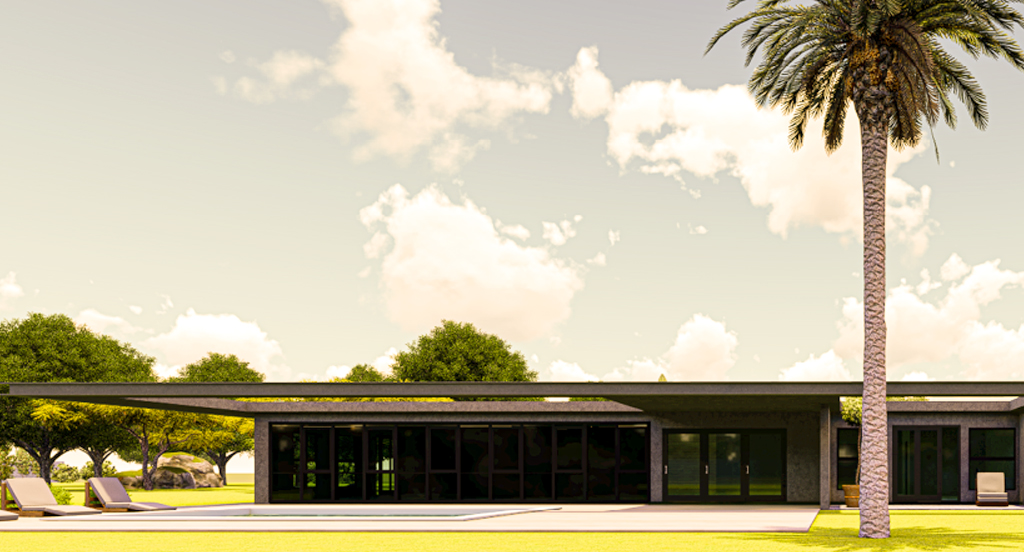1ST: TAPIWANASHE MBIRE
DESIGN INTENT
The intent of this intervention is to identify materials, planning and spatial conditions that provide robust housing that facilitates independent and isolated circulation, interchangeable programmes within living spaces, resilience to failed or suspended goods exchange systems (due to lockdown), engages regional economies, reflects the natural landscape and creates an appropriate environment for combating or resisting the symptomatic effects of covid-19 or any other corona virus’.
The planning strategy for this scheme was to negotiate internal and external programmes using multiple entrances to living/public spaces. this allows a visual interaction between occupants while using glazing thresholds to maintain social distancing protocols in the case that one member is self-isolating.
Although this intervention was designed to accommodate a young family of three with two professionally employed parents and a primary school child – all intending to work from home – or have the opportunity to do so, the scheme can be easily adaptable to fit new topographic or occupant conditions. particular emphasis was placed in developing designated and alternative workstations to bring variety to the living conditions of the occupants.
A neighbourly courtyard interaction was included to promote communal familiarity and relieve isolation in accordance with social distancing protocols. Materials used are intended to reduce dependency on transnational entities and bring upskilling to local contractors. the form is focused on bringing natural light and ventilation throughout all living spaces as a preventative measure against coronavirus ’.
Zimbabwe when translated means house of stone, vernacular practice of building with earth creates a regionally unique aesthetic as locally available soil conditions vary. Decolonial approaches to construction re-establish African identity and decrease dependence on exploitative facets of globalization.
DESIGN INTENT- PDF DOWNLOAD
PANEL 1- PDF DOWNLOAD
PANEL 2 – PDF DOWNLOAD
2ND: MTHOKOZISI ORLENCE SIBANDA
Concept – Refuge
The environment that surrounds us directly affects the way we feel, it has the potential to attenuate or exacerbate sensations. During the pandemic people have retreated back to their homes for refuge against the spreading virus. It is now a new normal to work or study from home. For this reason, a home must be a therapeutic place that helps in healing its habitat, a true reflection of refuge.
This has been archived through the biophilic design strategy. The house provides a healing environment for the habitat at a low-cost budget through sustainability approach and environmental consciousness. The sleeping spaces are on the eastern side with a courtyard in between. The courtyard provides the habitat with an experience of nature and enhances the quality of air into the house through ventilation. Openings offer some beautiful unobstructed panoramic views, natural lighting and cross ventilation. This therefore increases the immunity of the habitat. Vinyl has been used for interior flooring as it easy to clean and archive sterile surfaces. More so, vinyl can imitate some natural textures which enhances the healing effect of the home.
The living spaces are open in their configuration which enhances transparency and a quick flow of natural light. The outdoor spaces which cover 160 square meters of the total plinth area, offer a feel of tranquil and serenity to the habitat as it opens out to the landscape thus creating a healing environment around the house.
The building also collects its own water and manages its waste water to help against the water crisis in the city and in the country at large. Automated venetian blinds control the natural lighting into the living spaces and also offer security. The house therefore, opens out into the prospect (landscape) and at the same time provides refuge for the habitat.
DESIGN INTENT- PDF DOWNLOAD
PANEL 1- PDF DOWNLOAD
PANEL 2 – PDF DOWNLOAD
3RD: DAVID PETER MADZIATAYIKA
THE HOUSE AS A FORCE OF EXCELLENT WELL BEING
This is a 144.900m² house on a site of about 578,158m², designed particularly for three members. A father who is a famer, mother who is a teacher and a daughter who is a student. Covid-19 has shaken the normal way of living and home is now the place where they will be spending most of their time. The need for a cleaner and safer house hold is now direr that ever before. And this is how this house design responds to this need in this fight against corona virus.
OPENINGS
The front door has a tap, copper coated tap to be specific. This will be used to clean hands before handling the door or entering the interior spaces. Behind the tap there is an elevated perforated wall for aesthetics as well as allowing air flow to keep the tap dry at all times.
Height. The width has been narrowed down to reduce cost of glass. Instead louvres have been used instead. These are in two levels. The lower and higher level to take advantage of stack ventilation as a way of naturally ventilating these spaces. This also allows adequate entry of sunlight which gives vitamin D which is also essential for healthy life (As opposed to artificial lighting)
ROOMS
There are two bedrooms, one for parents and the other for the daughter. Adequate space has been given for storage, bed space as well as a table for working/studying as well as online meetings. To make sure sound is blocked, the rooms are situated at the back of the site (south), away from the main road and close to vegetation for fresh air and also as a buffer for noise.
HOW SPACES TRANSFORM
A movable folding wall demarcates the lounge from the dining. This is to supply extra spaces in case a member gets sick. Folding the wall creates extra bed space.
MATERIALS
Compressed stabilized earth from the same site will be used for construction. Thus leaving the top soil intact to allow growth of plants to consumption as well as ground cover to stop run-off.
All frames, from door to windows are to be copper coated due to its ability to kill bacteria. The floor has a finish of polished concrete to increase cleaning efficiency and it’s lower in cost.
LIGHTING/ VENTILATION AND LIVING ESSENTIALS
Adequate natural light and sir is able to circulate In and out of the through the large windows and louvres. For the corridor, a skylight distributes lights across its volume. Taking advantage of the sun, solar panels have proposed as an electricity source to reduce cost of living.
On the same point of living garden space has been kept at the back for crop farming. To maximize the space a 1000mm wide wooden platform run around the wall perimeter, creating more space for poted plants as well as necessitating the interaction of neighbors at the same time observing social distancing.
An Eco-san toilet completes it all as it will provide organic fertilizer for the plants as opposed to inorganic ones that destroy our eco system.
DESIGN INTENT- PDF DOWNLOAD
PANEL 1- PDF DOWNLOAD
PANEL 2 – PDF DOWNLOAD
HIGHLY COMMENDED: REJOICE USAI
THE ROSE BUSH
As the COVID-19 pandemic swept up through the world, it became increasingly apparent that the built environment had to be part of the solution in the aftermath of the pandemic. However there was a lot of chaos around the world which led to people on focusing on the bad side of the pandemic rather than the positive push that it brought in all the sectors. Like they said “Instead of complaining that the Rose Bush is full of thorns, be happy the thorn bush has Roses”.
With the inspiration emanating from the Rose bush, site and the existing shortcomings in preparedness, socio-economic safety nets and global cooperation, the concept also draws attention to its ability to the realization of how the built environment would solve the issues faced during the pandemic bringing home, work and play in one net. This then solves the problems of going to work every day at the same time maximizing human interaction at home.
In response to this reality, the design takes into consideration issues such as
1. Understanding inter-depencies exposed by crisis
2. Responding to institutional change in the midst of crisis response
3. Build back better policies
4. Regenerative designing
This net-positive and holistic approach is a radical change of perspective that can be described with the expression “from less bad to more good”. This is the core principle I have used as the back bone of my design. Instead of having air-conditioning systems that spread the virus, anti-microbacterial conditioning has been in cooperated in the design to purify and sterilize the air around the house. Most spaces will be receiving natural light which allows Ultra violet rays to penetrate in the house and kill the virus.
Public spaces and private areas have been separated to reduce the spread of unknown virus that visitors might bring in the proximity. The materiality tries to make use of as much as easy sanitized profiles and motifs that do not keep germs for a very long time on the exposed surfaces. Natural stone and SIPs (Structural insulated panels) and rammed earth and hemp Crete have been used as structural material that is later cladded.
DESIGN INTENT- PDF DOWNLOAD
PANEL 1- PDF DOWNLOAD
PANEL 2 – PDF DOWNLOAD
HIGHLY COMMENDED: SIMBARASHE ALVIN MATEMA
I intend to design a living unit which conforms with a pre-Covid world in as much as space configuration and function is concerned. The spaces such as bedrooms are designed to interact with the outside world through access to the outdoors. This creates a psychologically soothing and ambient environment when one is isolated in their room due to sickness. There are also en-suites in all bedrooms for greater privacy and independence from unnecessary movement through the house. The living area also has guest ablution facilities which can be used by all occupants when they are interacting in the living, kitchen, and dining area.
The bedrooms and studio all have patios to link the inside to the outside for sun-basking and absorbing vitamin D in this Covid 19 pandemic. There is also a deck and pool area for outdoor recreation, At the main entrance in the portico there is a wash basin to wash and sanitize hands, and a vestibule inside where guests can leave coats and jackets and also leave their shoes then wash their hands and sanitize at a wash basin inside then gain access into the house. The garage also has a wash basin point. All this is to ensure guests and occupants of the living unit sanitize their hands before entering the house. Floors are ceramic tiles which are easy to clean, counter tops are marble and door handles are brass. These materials are easy to sanitize. The passage is glazed on one side for natural daylight to flood in during the day, and the sunlight is also a good sanitizer on material surfaces.
The living unit is for a family of 3; an architect father, doctor mother, and 12 year old son in primary school. The spaces are configured in such a way that the father has his at-home studio where he can work, the mother can have uninterrupted sleep when home from a night shift, and the son has a work station set up in his room for studying and online learning. The mother may also use the husband’s studio for online meetings.
The living unit is to be self sufficient and use green energy. There will be underground water storage so as to not have tanks around the site disturbing the natural environment aesthetic. Water will be collected from the roof drainage and piped down to the tanks during the rainy season, and from a borehole during the dry season, The water will be pumped up for domestic use by a pump powered by solar energy. Solar energy will also provide green energy for the entire living unit. The design is to be contemporary with a granite tone matching the rock outcrops around the area. The aesthetics will also exhibit the affluence of the location of the
living unit.
DESIGN INTENT- PDF DOWNLOAD
PANEL 1- PDF DOWNLOAD
PANEL 2 – PDF DOWNLOAD
